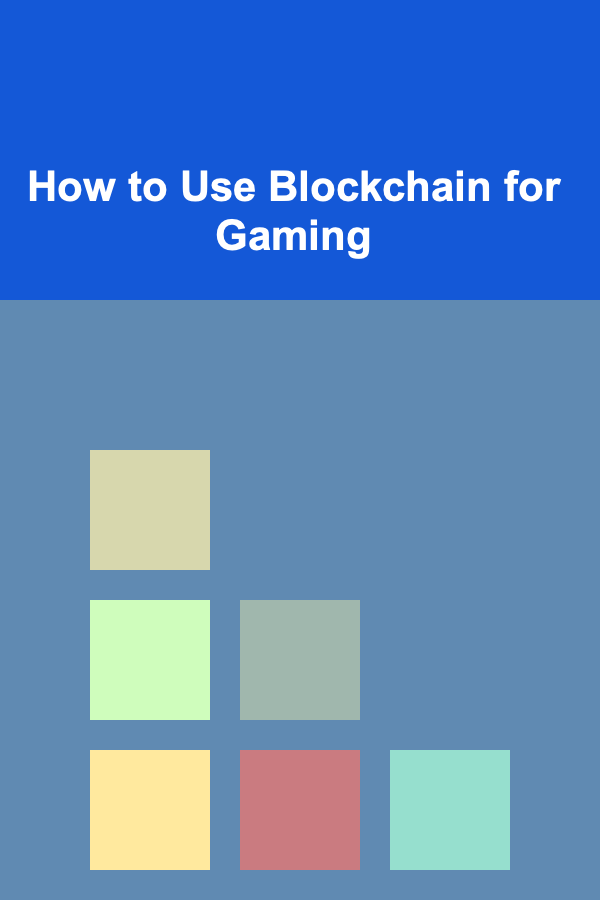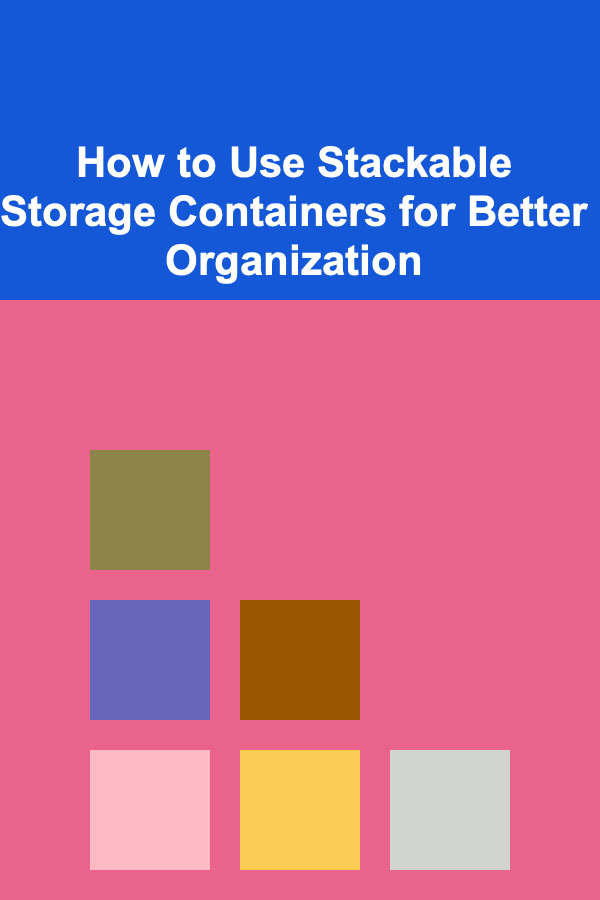
How to Use Blockchain for Gaming
ebook include PDF & Audio bundle (Micro Guide)
$12.99$7.99
Limited Time Offer! Order within the next:

Blockchain technology, which gained significant attention through its association with cryptocurrencies like Bitcoin and Ethereum, is now making waves in various industries, including gaming. The gaming world, traditionally based on centralized systems, is now exploring how decentralized networks, powered by blockchain, can transform the industry. With its ability to offer transparency, security, and ownership, blockchain has the potential to revolutionize gaming by reshaping how players interact with games, own digital assets, and participate in the gaming economy.
In this article, we will explore how blockchain can be applied to gaming, the benefits it offers, the challenges it faces, and its future implications for the industry.
Understanding Blockchain Technology
Before diving into how blockchain can be used in gaming, it's essential to understand what blockchain is and how it works.
Blockchain is a distributed ledger technology that stores data across a decentralized network of computers (nodes). Each block in the chain contains a record of transactions or data, and once a block is added to the chain, it is immutable, meaning it cannot be altered or deleted. This decentralized and tamper-resistant nature of blockchain ensures transparency and trust in the system.
The key components of blockchain technology include:
- Decentralization: No central authority controls the blockchain network; instead, it operates on a peer-to-peer basis.
- Immutability: Once data is written to the blockchain, it cannot be changed, providing a high level of security.
- Smart Contracts: These are self-executing contracts with the terms directly written into code. They automatically execute actions once certain conditions are met.
- Tokens: Cryptographic tokens, which can represent various assets such as currency, items, or even ownership rights.
With this understanding, let's examine how these features can be applied to gaming.
Blockchain's Role in Gaming
1. Ownership of In-Game Assets
One of the most exciting possibilities blockchain brings to gaming is the concept of true ownership of in-game assets. In traditional gaming environments, players purchase virtual items such as skins, weapons, and characters, but they do not truly "own" these assets. The game publisher or developer retains ownership, and players are often limited in how they can use or transfer these items.
With blockchain, in-game assets can be tokenized as Non-Fungible Tokens (NFTs), allowing players to own and control their items outside of the game's central system. An NFT is a unique, verifiable digital asset stored on the blockchain, representing a particular item or asset in a game. Players can trade, sell, or even transfer these NFTs across different games or platforms, creating an open market for digital goods.
For example, a player might buy a rare sword in one game, and then trade or sell it to someone else in another game that supports the same blockchain network. This level of interoperability and true ownership of in-game assets is one of the most revolutionary aspects of blockchain in gaming.
2. Play-to-Earn (P2E) Economy
Blockchain enables a new model for gaming known as "Play-to-Earn" (P2E). Traditionally, gaming has been a consumer-driven experience, where players spend money to buy games or in-game purchases. With blockchain technology, a P2E model allows players to earn valuable assets while playing.
In a P2E game, players can earn cryptocurrency, NFTs, or other digital assets as rewards for their in-game achievements. These rewards are typically tied to the blockchain, meaning that players can sell or trade them on decentralized marketplaces. This creates a new economy where players can monetize their gaming experience.
Several blockchain-based games, like Axie Infinity and The Sandbox, have gained popularity by incorporating P2E mechanisms. In these games, players earn tokens or assets by participating in various in-game activities, such as completing quests, battling, or creating content. These assets can be traded for real-world value, allowing players to earn income through gaming.
3. Decentralized Gaming Platforms
Traditional gaming platforms like Steam, Xbox Live, and PlayStation Network are centralized, meaning they are controlled by a single entity that governs the games, transactions, and content within the platform. Blockchain can decentralize these platforms, giving players and developers more control over the gaming experience.
Decentralized gaming platforms are built on blockchain networks, allowing game developers to publish games and monetize them without relying on a centralized authority. These platforms enable players to engage with games in a peer-to-peer manner, eliminating the need for intermediaries and reducing the risk of censorship.
Additionally, decentralized platforms can provide more equitable revenue distribution for developers. Rather than a large portion of the revenue going to the platform owner (e.g., Steam or the App Store), blockchain-based platforms can enable direct transactions between players and developers, ensuring that more of the profits go to the creators of the game.
4. Smart Contracts for Game Mechanics
Smart contracts, a key feature of blockchain, can be used to automate various aspects of game mechanics. In traditional games, certain events, such as the distribution of rewards or the execution of in-game transactions, are managed by the game's centralized servers. With smart contracts, these processes can be automated and executed directly on the blockchain.
For example, a smart contract could be used to automatically award a player an NFT when they complete a certain quest or achieve a milestone in the game. This eliminates the need for a centralized authority to process the transaction, ensuring that the process is transparent, fair, and tamper-proof.
Smart contracts can also be used for more complex game mechanics, such as in-game governance or token staking. In decentralized autonomous organizations (DAOs), players may be able to vote on game updates or changes, with the decisions being automatically executed through smart contracts.
5. Decentralized Autonomous Organizations (DAOs) in Gaming
A DAO is a decentralized organization that operates based on rules encoded in smart contracts, with decisions being made by the community of token holders. In the context of gaming, DAOs can give players more influence over the development and direction of a game or gaming ecosystem.
For instance, a game developer could create a DAO to govern the development of a game. Players who hold the game's token would have voting rights, allowing them to participate in decisions such as game updates, in-game policies, and resource allocation. This creates a more community-driven approach to game development, ensuring that players have a direct say in the games they love.
Additionally, DAOs can be used to support player-driven economies. Players could vote on the distribution of rewards, determine in-game asset prices, and even create new features or content for the game. This level of community engagement and decentralized decision-making could foster a more vibrant and dynamic gaming ecosystem.
6. Interoperability Between Games
One of the most promising applications of blockchain in gaming is the ability to create a connected ecosystem where assets can be shared between different games. Interoperability allows players to use the same digital assets, such as NFTs or tokens, across multiple games or platforms.
For example, a player might purchase a special weapon in one game, and then use it in another game that is also built on the same blockchain network. This opens up new possibilities for cross-game interaction and asset usage, allowing players to carry their investments across different experiences.
Interoperability is still in its early stages, but several projects, such as Enjin and The Sandbox, are working on creating blockchain-based gaming ecosystems that support cross-game interoperability.
Challenges in Implementing Blockchain in Gaming
Despite the promising potential of blockchain for gaming, there are several challenges that need to be addressed before widespread adoption can occur.
1. Scalability
Blockchain networks, especially those that are public and decentralized, can struggle with scalability. As the number of players and transactions increases, blockchain networks may experience congestion, leading to slower transaction times and higher fees. This can be problematic for gaming, where real-time transactions and low fees are critical for smooth gameplay.
To overcome scalability issues, many blockchain projects are working on layer-2 solutions, which are secondary networks built on top of existing blockchains. These solutions, such as Polygon and Optimism, aim to reduce transaction costs and improve speed, making them more suitable for gaming applications.
2. User Experience
Blockchain technology can be complex for the average user. Setting up a wallet, managing private keys, and understanding the intricacies of NFTs and tokens can be overwhelming for players who are not familiar with cryptocurrency. To fully integrate blockchain into gaming, developers need to focus on simplifying the user experience, making it as seamless as possible for players to interact with blockchain features without feeling like they're dealing with complicated technology.
3. Regulatory Uncertainty
As blockchain and cryptocurrency become more mainstream, governments and regulatory bodies are starting to pay closer attention to the industry. The regulatory environment for blockchain-based gaming is still evolving, and there is uncertainty about how different countries will regulate NFTs, cryptocurrency, and other blockchain-based assets.
Game developers and players will need to navigate these regulations carefully, especially as new laws are enacted regarding digital assets, taxes, and gaming content. This could impact the development and monetization of blockchain-based games.
4. Environmental Impact
Many blockchain networks, especially those that use proof-of-work (PoW) consensus mechanisms (such as Ethereum), have been criticized for their environmental impact due to the high energy consumption required for mining. Although there is a growing shift toward more energy-efficient consensus models, such as proof-of-stake (PoS), the environmental impact remains a concern for some players and developers.
The Future of Blockchain in Gaming
Despite the challenges, the potential benefits of blockchain for gaming are undeniable. As blockchain technology continues to evolve, we can expect to see more games adopting blockchain-based features, creating a more transparent, player-driven, and decentralized gaming ecosystem. The rise of Play-to-Earn games, true ownership of digital assets, and decentralized governance models are just the beginning of what blockchain can offer to the gaming industry.
In the coming years, blockchain may become a standard feature in gaming, similar to how the internet transformed the way games are distributed and played. The gaming community, developers, and regulators will need to work together to address the challenges and make blockchain gaming more accessible, sustainable, and user-friendly.
Ultimately, blockchain has the potential to empower players, create new revenue streams for developers, and open up new possibilities for the gaming world. As the technology matures and the gaming industry embraces its potential, blockchain will likely become a cornerstone of the future of gaming.

How to Build a Checklist for Car Safety Features Maintenance
Read More
How to Use Stackable Storage Containers for Better Organization
Read More
Smart Shopping Tips for Saving Money on Groceries Without Cutting Corners
Read More
Top Public Transportation Alternatives for Reducing Your Carbon Footprint
Read More
How to Plan a Community Cleanup Event on a Budget
Read More
How to Integrate Your Blog Planner with Your Social Media Strategy
Read MoreOther Products

How to Build a Checklist for Car Safety Features Maintenance
Read More
How to Use Stackable Storage Containers for Better Organization
Read More
Smart Shopping Tips for Saving Money on Groceries Without Cutting Corners
Read More
Top Public Transportation Alternatives for Reducing Your Carbon Footprint
Read More
How to Plan a Community Cleanup Event on a Budget
Read More